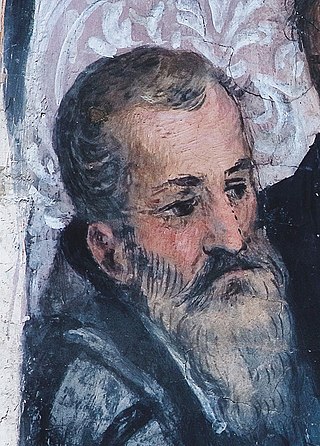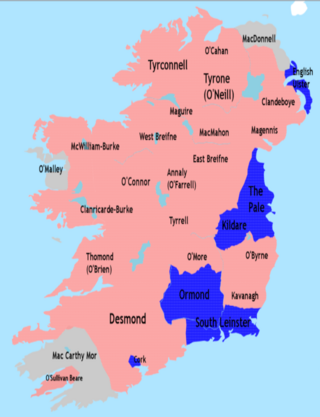Related Research Articles

Hugh O'Neill, was an Irish Gaelic lord, Earl of Tyrone and was later created The Ó Néill Mór, Chief of the Name. O'Neill's career was played out against the background of the Tudor conquest of Ireland, and he is best known for leading a coalition of Irish clans during the Nine Years' War, the strongest threat to the House of Tudor in Ireland since the uprising of Silken Thomas against King Henry VIII.

Shane O'Neill, was an Irish chieftain of the O'Neill dynasty of Ulster in the mid-16th century. Shane O'Neill's career was marked by his ambition to be the O'Neill—sovereign of the dominant O'Neill family of Tír Eoghain. This brought him into conflict with competing branches of the O'Neill family and with the English government in Ireland, who recognised a rival claim. Shane's support was considered worth gaining by the English even during the lifetime of his father Conn O'Neill, 1st Earl of Tyrone. But rejecting overtures from Thomas Radclyffe, 3rd Earl of Sussex, the lord deputy from 1556, Shane refused to help the English against the Scottish settlers on the coast of Antrim, allying himself for a short time instead with the MacDonnells, the most powerful of these settlers. Shane viewed the Scottish settlers as invaders, but decided to stay his hand against them with hopes of using them to strengthen his position with the English. However, tensions quickly boiled over and he declared war on the Scottish MacDonnell's defeating them at the Battle of Glentaisie despite the MacDonnells calling for reinforcements from Scotland. The Scottish MacDonnells would later assassinate Shane O'Neill and collect the bounty on his head.
Conn Bacagh O'Neill, 1st Earl of Tyrone, was king of Tyrone. In 1541 O'Neill travelled to England to submit to Henry VIII as part of the surrender and regrant policy that coincided with the creation of the Kingdom of Ireland. He was made Earl of Tyrone, but his plans to pass the title and lands on to a chosen successor Matthew were thwarted by a violent succession dispute that led to another son, Shane O'Neill, emerging triumphant.
The Earl of Tyrone is a title created three times in the Peerage of Ireland.

Sir Phelim Roe O'Neill of Kinard was an Irish politician and soldier who started the Irish rebellion in Ulster on 23 October 1641. He joined the Irish Catholic Confederation in 1642 and fought in the Wars of the Three Kingdoms under his cousin, Owen Roe O'Neill, in the Confederate Ulster Army. After the Cromwellian conquest of Ireland O’Neill went into hiding but was captured, tried and executed in 1653.

The Nine Years' War, sometimes called Tyrone's Rebellion, took place in Ireland from 1593 to 1603. It was fought between an Irish alliance—led mainly by Hugh O'Neill of Tyrone and Hugh Roe O'Donnell of Tyrconnell—against English rule in Ireland, and was a response to the ongoing Tudor conquest of Ireland. The war was fought in all parts of the country, but mainly in the northern province of Ulster. The Irish alliance won some important early victories, such as the Battle of Clontibret (1595) and the Battle of the Yellow Ford (1598), but the English won a victory against the alliance and their Spanish allies in the siege of Kinsale (1601–02). The war ended with the Treaty of Mellifont (1603). Many of the defeated northern lords left Ireland to seek support for a new uprising in the Flight of the Earls (1607), never to return. This marked the end of Gaelic Ireland and led to the Plantation of Ulster.
Shane O'Neill, 3rd Earl of Tyrone was the youngest son of Hugh O'Neill, Earl of Tyrone.

Tír Eoghain, also known as Tyrone, was a kingdom and later earldom of Gaelic Ireland, comprising parts of present-day County Tyrone, County Armagh, County Londonderry and County Donegal (Raphoe). The kingdom represented the core homeland of the Cenél nEógain people of the Northern Uí Néill and although they ruled, there were smaller groups of other Gaels in the area. One part of the realm to the north-east broke away and expanded, becoming Clandeboye, ruled by a scion branch of the O'Neill dynasty. In one form or another, Tyrone existed for over a millennium. Its main capital was Dungannon, though kings were inaugurated at Tullyhogue Fort.

The O'Neill dynasty are a lineage of Irish Gaelic origin that held prominent positions and titles in Ireland and elsewhere. As kings of Cenél nEógain, they were historically the most prominent family of the Northern Uí Néill, along with the O'Donnell dynasty. The O'Neills hold that their ancestors were kings of Ailech during the Early Middle Ages, as descendants of Niall of the Nine Hostages.
Con(n) MacShane O'Neill (1565–1630) was an Irish flaith or Prince of Ulster, the Lord of Clabbye, nobleman, rebel, and political leader in the late 16th century and early 17th century.
Catherine O'Neill, Countess of Tyrone was an Irish aristocrat. Born Catherine Mageniss she was the final wife of Hugh O'Neill, Earl of Tyrone, one of the leading Gaelic lords in Ireland during the late Elizabethan and early Stuart eras. Catherine was part of the Magennis dynasty, a powerful family in County Down The marriage, like Tyrone's earlier relationships, was a political one.
Matthew O'Neill, 1st Baron Dungannon, was an Irish aristocrat. He was accepted by Conn O'Neill as his natural son. Matthew was challenged by his half-brother Shane O'Neill over the succession to the Earldom of Tyrone and was murdered by some of his supporters.
Sir Cormac MacBaron O'Neill (d.1613) was an Irish soldier and landowner of the Elizabethan and early Stuart eras. He was part of the O'Neill dynasty, one of the most prominent Gaelic family in Ireland.
Art MacBaron O'Neill was an Irish landowner and soldier of the Elizabethan and early Stuart eras. He is sometimes referred to as Arthur O'Neill.
Brian MacArt O'Neill was a member of the O'Neill Dynasty, the leading Gaelic family of Ulster. He was the son and heir of Art MacBaron O'Neill of Oneilland and a grandson of Matthew O'Neill, 1st Baron Dungannon. He may have taken part in Tyrone's Rebellion, a conflict in which several of his brothers were killed. Along with the rest of his family he was pardoned as part of the Treaty of Mellifont in 1603.
Sir Turlough McHenry O'Neill is known for having been killed together with his father, Henry, fighting for the crown in O'Doherty's Rebellion and for being the father of Sir Phelim O'Neill, who started the Irish Rebellion of 1641.
Rosa O'Neill was a member of the O'Doherty family of County Donegal who lived during the late Tudor and Stuart eras.
Cathbarr O'Donnell was an Irish nobleman.
Art Oge O'Neill was a member of the O'Neill Dynasty of Tír Eoghain, Ulster, in medieval Ireland during the early Tudor era. In 1513 he became head of the O'Neills, holding the position until 1519 when he was succeeded by his half-brother.
Nuala O'Donnell was a member of the O'Donnell dynasty in sixteenth century Ireland who took part in the 1607 Flight of the Earls.